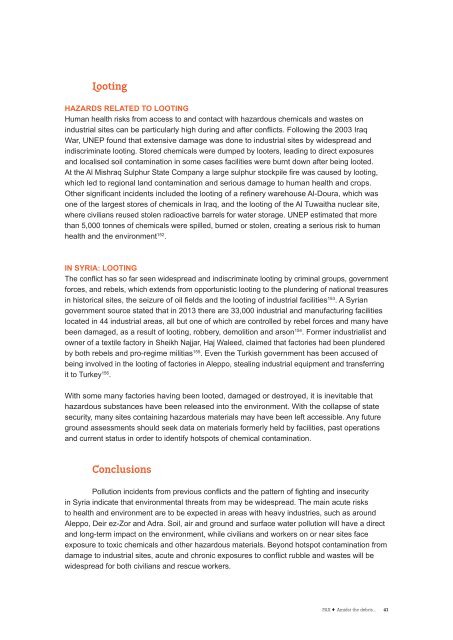Amidst the debris..
pax-report-amidst-the-debris-syria-web
pax-report-amidst-the-debris-syria-web
You also want an ePaper? Increase the reach of your titles
YUMPU automatically turns print PDFs into web optimized ePapers that Google loves.
Looting<br />
HAZARDS RELATED TO LOOTING<br />
Human health risks from access to and contact with hazardous chemicals and wastes on<br />
industrial sites can be particularly high during and after conflicts. Following <strong>the</strong> 2003 Iraq<br />
War, UNEP found that extensive damage was done to industrial sites by widespread and<br />
indiscriminate looting. Stored chemicals were dumped by looters, leading to direct exposures<br />
and localised soil contamination in some cases facilities were burnt down after being looted.<br />
At <strong>the</strong> Al Mishraq Sulphur State Company a large sulphur stockpile fire was caused by looting,<br />
which led to regional land contamination and serious damage to human health and crops.<br />
O<strong>the</strong>r significant incidents included <strong>the</strong> looting of a refinery warehouse Al-Doura, which was<br />
one of <strong>the</strong> largest stores of chemicals in Iraq, and <strong>the</strong> looting of <strong>the</strong> Al Tuwaitha nuclear site,<br />
where civilians reused stolen radioactive barrels for water storage. UNEP estimated that more<br />
than 5,000 tonnes of chemicals were spilled, burned or stolen, creating a serious risk to human<br />
health and <strong>the</strong> environment 152 .<br />
IN SYRIA: LOOTING<br />
The conflict has so far seen widespread and indiscriminate looting by criminal groups, government<br />
forces, and rebels, which extends from opportunistic looting to <strong>the</strong> plundering of national treasures<br />
in historical sites, <strong>the</strong> seizure of oil fields and <strong>the</strong> looting of industrial facilities 153 . A Syrian<br />
government source stated that in 2013 <strong>the</strong>re are 33,000 industrial and manufacturing facilities<br />
located in 44 industrial areas, all but one of which are controlled by rebel forces and many have<br />
been damaged, as a result of looting, robbery, demolition and arson 154 . Former industrialist and<br />
owner of a textile factory in Sheikh Najjar, Haj Waleed, claimed that factories had been plundered<br />
by both rebels and pro-regime militias 155 . Even <strong>the</strong> Turkish government has been accused of<br />
being involved in <strong>the</strong> looting of factories in Aleppo, stealing industrial equipment and transferring<br />
it to Turkey 156 .<br />
With some many factories having been looted, damaged or destroyed, it is inevitable that<br />
hazardous substances have been released into <strong>the</strong> environment. With <strong>the</strong> collapse of state<br />
security, many sites containing hazardous materials may have been left accessible. Any future<br />
ground assessments should seek data on materials formerly held by facilities, past operations<br />
and current status in order to identify hotspots of chemical contamination.<br />
Conclusions<br />
Pollution incidents from previous conflicts and <strong>the</strong> pattern of fighting and insecurity<br />
in Syria indicate that environmental threats from may be widespread. The main acute risks<br />
to health and environment are to be expected in areas with heavy industries, such as around<br />
Aleppo, Deir ez-Zor and Adra. Soil, air and ground and surface water pollution will have a direct<br />
and long-term impact on <strong>the</strong> environment, while civilians and workers on or near sites face<br />
exposure to toxic chemicals and o<strong>the</strong>r hazardous materials. Beyond hotspot contamination from<br />
damage to industrial sites, acute and chronic exposures to conflict rubble and wastes will be<br />
widespread for both civilians and rescue workers.<br />
PAX ! <strong>Amidst</strong> <strong>the</strong> <strong>debris</strong>...<br />
41


